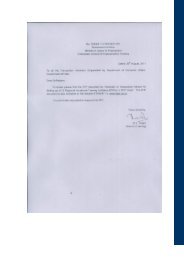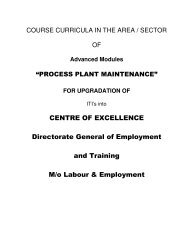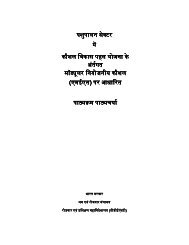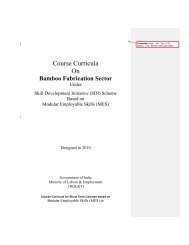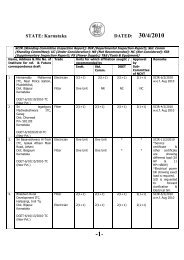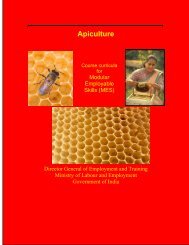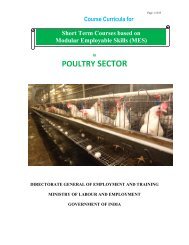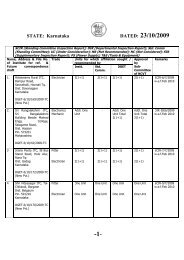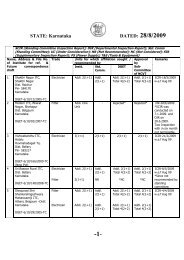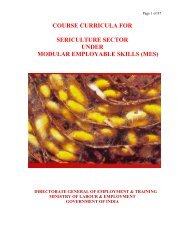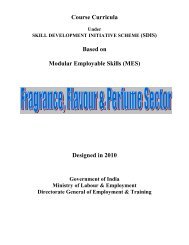Electrical - Directorate General of Employment & Training
Electrical - Directorate General of Employment & Training
Electrical - Directorate General of Employment & Training
You also want an ePaper? Increase the reach of your titles
YUMPU automatically turns print PDFs into web optimized ePapers that Google loves.
Course Curricula<br />
for<br />
Short Term Courses based on<br />
Modular Employable Skills (MES)<br />
in<br />
ELECTRICAL Sector<br />
DIRECTORATE GENERAL OF EMPLOYMENT AND TRAINING<br />
MINISTRY OF LABOUR & EMPLOYMENT<br />
GOVERNMENT OF INDIA
Course Curricula for Short Term Courses based on Modular<br />
Employable Skills (MES) in the <strong>Electrical</strong> Sector<br />
CONTENTS<br />
1. Background ................................................................................................................... 2<br />
2. Frame Work for Skill Development based on Modular Employable Skills ..................... 2<br />
3. Age <strong>of</strong> Participants ......................................................................................................... 3<br />
4. Curriculum Development Process .................................................................................. 3<br />
5. Development <strong>of</strong> Core Competencies ............................................................................. 3<br />
6. Duration <strong>of</strong> the Programmes .......................................................................................... 4<br />
7. Pathways to acquire Qualification .................................................................................. 4<br />
8. Methodology .................................................................................................................. 5<br />
9. Instructional Media Packages ........................................................................................ 5<br />
10. Assessment ................................................................................................................... 5<br />
11. Certificate ...................................................................................................................... 5<br />
12. Course Matrix ................................................................................................................ 6<br />
13. Module ........................................................................................................................... 7<br />
14. Basic <strong>Electrical</strong> <strong>Training</strong> ................................................................................................. 7<br />
15. Repair <strong>of</strong> Home Appliance ............................................................................................. 9<br />
16. House Wiring ............................................................................................................... 11<br />
17. Electronic Choke & CFL Assembling ........................................................................... 13<br />
18. Transformer Winding ................................................................................................... 14<br />
19. Armature Winding ........................................................................................................ 15<br />
20. Rewinding <strong>of</strong> AC/DC Motors ........................................................................................ 16<br />
21. Repair <strong>of</strong> <strong>Electrical</strong> Power Tools .................................................................................. 17<br />
22. Maintenance <strong>of</strong> Batteries ............................................................................................. 19<br />
23. List <strong>of</strong> Expert/Trade Committee Members .................................................................... 20<br />
1
Skill Development based on Modular Employable Skills (MES)<br />
Background<br />
The need for giving emphasis on the Skill Development, especially for the less<br />
educated, poor and out <strong>of</strong> school youth has been highlighted in various forums. The skill<br />
level and educational attainment <strong>of</strong> the work force determines the productivity, income levels<br />
as well as the adaptability <strong>of</strong> the working class in changing environment. Large percentage<br />
<strong>of</strong> population in India is living below poverty line. One <strong>of</strong> the important causes is lower<br />
percentage <strong>of</strong> skilled persons in the workforce<br />
The skill development at present is taking place mostly in the informal way, i.e.<br />
persons acquire skill at the work-place when they help their parents, relatives and employers<br />
etc. Such persons do not have a formal certificate and thus earn lower wages and are<br />
exploited by employers. They have come through informal system due to socio-economic<br />
circumstances <strong>of</strong> the family and the compulsions <strong>of</strong> earning a livelihood rather than<br />
attending a formal course. While their productivity is low, their contribution to the national<br />
GDP cannot be ignored. If the country can create a system <strong>of</strong> certification which not only<br />
recognizes their skills but also provides education and training in a mode that suits their<br />
economic compulsions, it will not only benefit the workforce to earn a decent living but also<br />
contribute to the national economy by better productivity <strong>of</strong> this workforce.<br />
Another related problem to be tackled is large number <strong>of</strong> students drop outs (About<br />
63% <strong>of</strong> the school students drop out at different stages before reaching Class-X).<br />
Frame work for Skill Development based on ‘Modular Employable Skills (MES)’<br />
Very few opportunities for skill development are available for the above referred<br />
groups (out <strong>of</strong> school youth & existing workers especially in the informal sector). Most <strong>of</strong> the<br />
existing Skill Development programmes are long term in nature. Poor and less educated<br />
persons can not afford long term training programmes due to higher entry qualifications,<br />
opportunity cost etc. Therefore, a new frame work for Skill Development for the Informal<br />
Sector has been evolved by the DGET to address to the above mentioned problems. The<br />
key features <strong>of</strong> the new frame work for skill development are:<br />
Demand driven Short term training courses based on modular employable skills<br />
decided in consultation with Industry<br />
Flexible delivery mechanism (part time, weekends, full time)<br />
Different levels <strong>of</strong> programmes (Foundation level as well as skill upgradation) to meet<br />
demands <strong>of</strong> various target groups<br />
Central Government will facilitate and promote training while Vocational <strong>Training</strong> (VT)<br />
Providers under the Govt. and Private Sector will provide training<br />
Optimum utilisation <strong>of</strong> existing infrastructure to make training cost effective.<br />
Testing <strong>of</strong> skills <strong>of</strong> trainees by independent assessing bodies who would not be<br />
involved in conduct <strong>of</strong> the training programme, to ensure that it is done impartially.<br />
Testing & certification <strong>of</strong> prior learning (skills <strong>of</strong> persons acquired informally)<br />
2
The Short Term courses would be based on „Modular Employable Skills (MES)‟.<br />
The concept for the MES is :<br />
<br />
<br />
<br />
<br />
<br />
Identification <strong>of</strong> „minimum skills set‟ which is sufficient to get an employment in the labour<br />
market.<br />
It allows skills upgradation, multiskilling, multi entry and exit, vertical mobility and life long<br />
learning opportunities in a flexible manner.<br />
It also allows recognition <strong>of</strong> prior learning (certification <strong>of</strong> skills acquired informally)<br />
effectively.<br />
The modules in a sector when grouped together could lead to a qualification equivalent<br />
to National Trade Certificate or higher.<br />
Courses could be available from level 1 to level 3 in different vocations depending upon<br />
the need <strong>of</strong> the employer organisations.<br />
MES would benefit different target groups like :<br />
o Workers seeking certification <strong>of</strong> their skills acquired informally<br />
o workers seeking skill upgradation<br />
o early school drop-outs and unemployed<br />
o previously child labour and their familly<br />
Age <strong>of</strong> participants<br />
The minimum age limit for persons to take part in the scheme is 14 years but there is<br />
no upper age limit.<br />
Curriculum Development Process<br />
Following procedure is used for developing course curricula<br />
• Identification <strong>of</strong> Employable Skills set in a sector based on division <strong>of</strong> work in the labour<br />
market.<br />
• Development <strong>of</strong> training modules corresponding to skills set identified so as to provide<br />
training for specific & fit for purpose<br />
• Organization <strong>of</strong> modules in to a Course Matrix indicating vertical and horizontal mobility.<br />
The course matrix depicts pictorially relation among various modules, pre requisites for<br />
higher level modules and how one can progress from one level to another.<br />
• Development <strong>of</strong> detailed curriculum and vetting by a trade committee and by the NCVT<br />
(Close involvement <strong>of</strong> Employers Organizations, State Governments, experts, vocational<br />
training providers and other stake holders is ensured at each stages).<br />
Development <strong>of</strong> Core Competencies<br />
Possession <strong>of</strong> proper attitudes is one <strong>of</strong> the most important attribute <strong>of</strong> a competent person.<br />
Without proper attitudes, the performance <strong>of</strong> a person gets adversely affected. Hence,<br />
systematic efforts will be made to develop attitudes during the training programme.<br />
The trainees deal with men, materials and machines. They handle sophisticated tools and<br />
instruments. Positive attitudes have to be developed in the trainees by properly guiding<br />
3
them and setting up examples <strong>of</strong> good attitudes by demonstrated behaviors and by the<br />
environment provided during training.<br />
Some important core competencies to be developed are:<br />
1. Safety consciousness and safe working practices<br />
2. Care <strong>of</strong> equipment and tools<br />
3. Punctuality, discipline and honesty<br />
4. Concern for quality<br />
5. Respect for rules and regulations<br />
6. Concern for health and hygiene<br />
7. Cordial relationship and Cooperation with co-workers and team Work<br />
8. Positive attitude and behavior<br />
9. Responsibility and accountability<br />
10. Learn continously<br />
11. Communication Skills<br />
12. Concern for environment and waste disposal<br />
Following competencies should also be developed during level-II and higher courses:<br />
1. Ability for planning, organizing and coordinating<br />
2. Creative thinking, problem solving and decision making<br />
3. Leadership<br />
4. Ability to bear stress<br />
5. Negotiation<br />
Duration <strong>of</strong> the Programmes<br />
Time taken to gain the qualification will vary according to the pathway taken and will be kept<br />
very flexible for persons with different backgrounds and experience. Duration has been<br />
prescribed in hours in the curriculum <strong>of</strong> individual module, which are based on the content<br />
and requirements <strong>of</strong> a MES Module. However, some persons may take more time than the<br />
prescribed time. They should be provided reasonable time to complete the course.<br />
Pathways to acquire Qualification:<br />
Access to the qualification could be through:<br />
• An approved training programme; Or<br />
• A combination <strong>of</strong> an approved training programme plus recognition <strong>of</strong> prior<br />
learning including credit transfer; Or<br />
• The recognition <strong>of</strong> prior learning that provides evidence <strong>of</strong> the achievement <strong>of</strong><br />
the competencies for the qualification.<br />
4
Methodology<br />
The training methods to be used should be appropriate to the development <strong>of</strong> competencies.<br />
The focus <strong>of</strong> the programme is on “performing” and not on “Knowing”. Lecturing will be<br />
restricted to the minimum necessary and emphasis to be given for „hands on training‟.<br />
The training methods will be individual centered to make each person a competent one.<br />
Opportunities for individual work will be provided. The learning process will be continuously<br />
monitored and feedback will be provided on individual basis.<br />
Demonstrations using different models, audio visual aids and equipment will be used<br />
intensively.<br />
Instructional Media Packages<br />
In order to maintain quality <strong>of</strong> training uniformly all over the country, instructional media<br />
packages (IMPs) will be developed by the National Instructional Media Institute (NIMI),<br />
Chennai.<br />
Assessment<br />
DGE&T will appoint assessing bodies to assess the competencies <strong>of</strong> the trained persons.<br />
The assessing body will be an independent agency, which will not be involved in conducting<br />
the training programmes. This, in turn, will ensure quality <strong>of</strong> training and credibility <strong>of</strong> the<br />
scheme. Keeping in view the target <strong>of</strong> providing training/testing <strong>of</strong> one million persons<br />
through out the country and to avoid monopoly, more than one assessing bodies will be<br />
appointed for a sector or an area.<br />
Certificate<br />
Successful persons will be awarded certificates issued by National Council for Vocational<br />
<strong>Training</strong> (NCVT).<br />
5
Course Matrix<br />
Proposed Course Outline/ Pathway<br />
Repair <strong>of</strong><br />
Home<br />
Appliance<br />
House<br />
Wiring<br />
<strong>Electrical</strong><br />
choke &<br />
CFL<br />
assembling<br />
Transformer<br />
Winding<br />
Armature<br />
Winding<br />
Repair <strong>of</strong><br />
AC/DC<br />
Motors<br />
Repair <strong>of</strong><br />
<strong>Electrical</strong><br />
Power Tools<br />
Maintenance<br />
<strong>of</strong><br />
Batteries.<br />
Power Transmission line<br />
Tower Erection<br />
Basic <strong>Electrical</strong> <strong>Training</strong><br />
Power Transmission Line<br />
Stringing<br />
6
MODULES<br />
Basic <strong>Electrical</strong> <strong>Training</strong><br />
Name<br />
: Basic <strong>Electrical</strong> <strong>Training</strong><br />
Sector<br />
: <strong>Electrical</strong><br />
Code<br />
: ELE101<br />
Entry Qualification<br />
: 5th Standard & 14 years and Above<br />
Duration<br />
: 120 Hrs<br />
Terminal competency: The participant will be able to<br />
State what is an accident, the probable causes and safe attitude<br />
Rescue a person who is in contact with a live wire<br />
Understand the general safety <strong>of</strong> Tools and Equipments<br />
Describe electricity, conductor, insulator, voltage, current, resistance, P.D., and inter<br />
relation between Voltage, Current, and Resistance etc.<br />
Connect volt meter, watt meter, ammeter, energy meter, multimeter, materials in<br />
simple electric circuits and measure the units.<br />
Do various connections like series, parallel etc.<br />
Explain the difference between AC & DC<br />
Describe the purpose <strong>of</strong> Earthing and Types <strong>of</strong> Earthing.<br />
Course contents:<br />
Underpinning Knowledge (Theory<br />
Practical Competencies<br />
Safety practice –<br />
Safety practices – lifting and handling.<br />
o Lifting and handling loads.<br />
o Heavy Equipments<br />
Safety practice –<br />
Safety practices – Fire fighting<br />
o Fire extinguishers<br />
o Types <strong>of</strong> fire extinguishers<br />
<strong>General</strong> safety <strong>of</strong> tools and equipments Nature <strong>of</strong> working <strong>of</strong> tools and<br />
equipments.<br />
<strong>Electrical</strong> safety<br />
<strong>Electrical</strong> safety practice<br />
o Rescue a person who is in contact<br />
with live wire.<br />
o Rescue a person who is in contact<br />
with live wire.<br />
o Treat a person for electric<br />
shock/injury.<br />
o Treat a person for electric<br />
shock/injury.<br />
Introduction to Electricity<br />
Prepare Terminations<br />
Conductors and types <strong>of</strong> conductors<br />
o Skinning Different types <strong>of</strong> cable<br />
Insulators and types <strong>of</strong> insulators<br />
ends<br />
Crimping & crimping tool<br />
o Make various joints in cable<br />
Soldering<br />
o Crimping cable ends.<br />
o Soldering the cable lugs<br />
Define simple electrical terms like voltage,<br />
current, resistance and their units.<br />
Simple electrical connections using<br />
resistance, voltmeter, and ammeter,<br />
multimeter<br />
Simple series and parallel circuits Connecting number <strong>of</strong> lamps in series<br />
connection.<br />
Connecting number <strong>of</strong> lamps in parallel<br />
connection.<br />
Direct current and testing the polarity<br />
Testing the polarity <strong>of</strong> DC supply.<br />
Alternating current and identifying phase,<br />
neutral and earth terminals<br />
Identification <strong>of</strong> phase and neutral in single<br />
phase supply<br />
Purpose <strong>of</strong> Earthing<br />
Carry out <strong>of</strong> pipe earthing<br />
Types <strong>of</strong> Earthing.<br />
Carry out <strong>of</strong> plate earthing<br />
o Pipe Earthing<br />
o Plate Earthing<br />
Simple house wiring circuit. Repairing <strong>of</strong> house wiring faults.
Tools and Equipments:<br />
1. Connector, 6”<br />
2. Screw Driver 8” 10”, 12”<br />
3. Cutting Pliers 6”, 8”<br />
4. Neon Tester<br />
5. Heavy Duty Screw Driver10”, 12”<br />
6. Nose Pliers 6”<br />
7. Crimping tool<br />
8. Volt meter 0-600 V (MC Type)<br />
9. Volt meter 0-600 V (MI Type)<br />
10. Ammeter 0-5 (MC Type)<br />
11. Ammeter 0-5 (MI Type)<br />
12. Watt meter 0-2.5KW<br />
13. Energy meter 0-10A,240V<br />
14. Multimeter<br />
15. Megger 500V<br />
16. Line Tester<br />
17. Types <strong>of</strong> fire extinguishers<br />
18. Common tools used in electrical field.<br />
19. Soldering iron 25W, 250V<br />
8
Repair <strong>of</strong> Home Appliance<br />
Name<br />
Sector<br />
Code<br />
Entry Qualification<br />
: Repair <strong>of</strong> Home Appliance<br />
: <strong>Electrical</strong><br />
: ELE202<br />
: 8 th Standard 14 years and Above<br />
MES Modules on Basic <strong>Electrical</strong> <strong>Training</strong><br />
Duration<br />
: 120 Hrs<br />
Terminal competency : The participant will be able to<br />
1. Observe the safety precautions while working<br />
2. Test line cord for continuity with test lamp/multimeter<br />
3. Prepare a heating element for a heater as required specification.<br />
4. Replace the old element for heater, kettle, non –automatic electronic<br />
iron, room heaters etc., with a new one<br />
5. Dismantle and reassemble an electric iron, heater, kettle,<br />
room heater, toaster, hair dryer, mixie etc.<br />
6. Install a ceiling fan and the regulator.<br />
7. Check a fluorescent lamp chock, starter and install it.<br />
Course contents:<br />
Underpinning Knowledge (Theory<br />
Practical Competencies<br />
Safety precaution Safety precaution<br />
Install, service and repair all kinds <strong>of</strong> electrical<br />
home appliances<br />
<strong>General</strong> repair <strong>of</strong> heating iron, kettle,<br />
ceiling fan, table fan, washing machine<br />
etc.,<br />
Test the fan capacitors.<br />
Clean and lubricate the bearing <strong>of</strong> ceiling<br />
and table fan, and check the speed.<br />
Regulator <strong>of</strong> both fan.<br />
Repair and rectification <strong>of</strong> an automatic electric<br />
iron, servicing and repairing <strong>of</strong> mixer, ceiling and<br />
Measure the insulation resistance between<br />
the terminals and body <strong>of</strong> the appliance<br />
table fan.<br />
Check the oscillator mechanisms <strong>of</strong> table<br />
fan<br />
Assemble and install a fluorescent6 lamp. Select the fuse size according to the load <strong>of</strong><br />
Thermostat heat controls <strong>of</strong> Automatic electric iron,<br />
steam iron, spray irons.<br />
Understand home appliances like heater, iron, kettle<br />
ceiling fan, table fan, washing machine etc.<br />
<br />
circuit<br />
Dismantle and reassemble automatic iron,<br />
ceiling fn table fan cooking range, storage<br />
heater, washing machines, and wet<br />
grinders etc.<br />
Maintenance <strong>of</strong> decorative serial lamp for a<br />
required supply voltage<br />
Assemble, connect and install a twin fluorescent<br />
lamp with accessories<br />
Repair and service technique <strong>of</strong> cooking range,<br />
storage water heater, washing machines, wet<br />
grinders. Replace the heating element in a soldering.<br />
<br />
<br />
<br />
<br />
Determine the number <strong>of</strong> lamps to be<br />
connected in series for particular supply<br />
voltage for making decorative serial lamp.<br />
Check the internal connections <strong>of</strong> cooking<br />
range selector switch and circuits.<br />
connections in different temperature<br />
arrangements<br />
Check the simple mechanical timer, small<br />
water pump <strong>of</strong> washing machines and<br />
regular service and faults.<br />
Repair <strong>of</strong> house wiring.<br />
9
Tools and Equipments:<br />
1. Electric Heater<br />
2. Electric Iron<br />
3. Electric Kettle<br />
4. Ceiling Fan<br />
5. Table Fan<br />
6. Washing Machine<br />
7. Automatic Iron<br />
8. Cooking Range<br />
9. Storage Heater<br />
10. Wet Grinder<br />
11. Connector, 6”<br />
12. Screw Driver 8” 10”, 12”<br />
13. Cutting Pliers 6”, 8”<br />
14. Neon Tester<br />
15. Heavy Duty Screw Driver10”, 12”<br />
16. Nose Pliers 6”<br />
17. Soldering iron<br />
18. Multimeter<br />
10
House wiring<br />
Name<br />
Sector<br />
Code<br />
Entry Qualification<br />
Duration<br />
Terminal competency:<br />
: House wiring<br />
: <strong>Electrical</strong><br />
: ELE203<br />
: 8 th Standard 14 years and Above<br />
MES Modules on Basic <strong>Electrical</strong> <strong>Training</strong><br />
:120 hrs<br />
The participant will be able to<br />
1. Observe the safety precautions while working<br />
2. List <strong>of</strong> necessary hand tools and their uses<br />
3. Cater and maintenance <strong>of</strong> wiring tools<br />
4. Draw and describe simple electrical circuits.<br />
5. Understand the different system <strong>of</strong> wiring used for domestic<br />
installation.<br />
6. Understand the necessity <strong>of</strong> good earthing in an electrical<br />
installation.<br />
7. Do the domestic installation testing before energizing a domestic<br />
installation.<br />
Course Contents:<br />
Underpinning Knowledge (Theory Practical Competencies<br />
Safety precaution Safety precaution<br />
Safety equipments that should be available<br />
with an electrician working on line<br />
electrical instillation.<br />
Common hand tools, their uses,<br />
care and maintenance.<br />
ISI rules related to wiring (<strong>General</strong>) Identify the wiring accessories as<br />
per symbols.<br />
Introduction to electricity<br />
Make simple twist joints<br />
Conductor & Insulator.<br />
Joints in <strong>Electrical</strong> Conductor<br />
Make married joint in stranded<br />
conductors.<br />
Make tee joint in stranded<br />
conductor.<br />
Diagram and systems used in domestic<br />
wiring installation<br />
Prepare T.W Board for fixing<br />
Flush type accessories.<br />
Make the wiring layout for a bed<br />
room <strong>of</strong> a house with 6 points.<br />
Carryout the wiring in PVC casing<br />
and capping as per layout.<br />
Earthing – Types.<br />
Earthing domestic installation<br />
I E rule for Energy meter Installation.<br />
<br />
<br />
<br />
Carryout pipe earthing pipe<br />
earthing as per I E rule.<br />
Prepare are mount energy meter<br />
board<br />
Carryout domestic installation<br />
testing<br />
11
Tools & Equipemnts:<br />
1. Screw Driver 8” 10”, 12”<br />
2. Combination Pliers 6”, 8”<br />
3. Neon Tester<br />
4. Round Nose Plier 15 cm<br />
5. Electrician Knife 10 cm<br />
6. Heavy Duty Screw Driver10”, 12”<br />
7. Nose Pliers 6”<br />
8. B.P.Hammer 1/2Kg,1/4Kg<br />
9. Cold Chisel 15 cm<br />
10. Tri Square 30 cm<br />
11. Fermer chisel 14cm,20cm,25cm<br />
12. Pocker 15cm<br />
13. Power drilling Machine 6 mm<br />
14. Hacksaw 30 cm<br />
15. Wire shipper 10 cm<br />
16. Measuring tape 5 meters<br />
12
Electronic Choke & CFL assembling<br />
Name<br />
: Electronic Choke & CFL assembling<br />
Sector<br />
: <strong>Electrical</strong><br />
Code<br />
: ELE204<br />
Entry Qualification<br />
: 8 th Standard 14 years and Above<br />
MES Modules on Basic <strong>Electrical</strong> <strong>Training</strong><br />
Duration<br />
: 120 hrs<br />
Terminal Competency The participant will be able to<br />
1. Observe the safety precautions while working<br />
2. Tell the resistance valve by seeing the colour coded resister and<br />
verify with the multimeter<br />
3. List the names <strong>of</strong> the Electronic components used in the circuit.<br />
4. Insert the components as per layout <strong>of</strong> PCB<br />
5. Solder the components.<br />
6. Taking the input and output leads.<br />
7. Test the assembled circuit.<br />
Course Contents:<br />
Underpinning Knowledge (Theory Practical Competencies<br />
Safety Precaution<br />
Safety Precaution<br />
Colour code <strong>of</strong> carbon resistors<br />
Practicing the color coded resistor valve<br />
then verifying with the miltimeter.<br />
Familiarization with different Electronic<br />
components used like capacitor, transistor,<br />
diode, choke coil etc.,<br />
Study the components symbol as per<br />
diagram<br />
Interpret the components as per circuit and<br />
laying the components on PCB<br />
Testing <strong>of</strong> assembled PCB<br />
Tools & Equipment:<br />
1 Soldering iron 25W, 230V<br />
2 Neon tester<br />
3 Multimeter<br />
4 Combination Plier.<br />
5 Nose plier<br />
6 Wire stripper<br />
7 Electrician Knife.<br />
Testing <strong>of</strong> different types <strong>of</strong> Electronic<br />
components.<br />
Practicing the symbol components as per<br />
diagram/circuit/<br />
Lay the components as per layout then<br />
soldering on PCB<br />
Trouble shooting if any on assembled<br />
circuit<br />
13
Transformer Winding<br />
Name<br />
: Transformer Winding<br />
Sector<br />
: <strong>Electrical</strong><br />
Code<br />
: ELE205<br />
Entry Qualification<br />
: 8th Standard 14 years and Above<br />
MES Modules on Basic <strong>Electrical</strong> <strong>Training</strong><br />
Duration<br />
120 hrs<br />
Terminal competency<br />
The Participant will be able to<br />
1. Dismantle the transformer cores<br />
2. Measure and also determine the size <strong>of</strong> winding wire for primary and secondary<br />
3. Take the dimensions <strong>of</strong> a bobbin and prepare the bobbin from suitable materials<br />
4. Wind the primary and secondary winding layer by layer.<br />
5. Stack the cores and fasten them<br />
6. Test the transformer for insulation, transformation ratio and performance<br />
Underpinning Knowledge (Theory Practical Competencies<br />
Safety precautions Safety precautions<br />
Identification <strong>of</strong> phase and neutral in<br />
single-phase A/C. supply,<br />
Testing the supply using test lamp<br />
with different wattage lamps.<br />
Test a single-phase transformer for its<br />
continuity and insulation.<br />
Take the dimensions <strong>of</strong> a bobbin<br />
and prepare the bobbin from<br />
Measuring a enameled winding wire with<br />
Std wire gauge.<br />
<br />
suitable materials<br />
Measure and also determine the size<br />
<strong>of</strong> winding wire for primary and<br />
secondary<br />
Wind/rewind a small transformer Dismantle /reassemble the<br />
transformer cores<br />
Wind the primary and secondary<br />
winding layer by layer.<br />
Use & Operation <strong>of</strong> hand operated and<br />
motorized coil winding machine.<br />
Impregnation Varnish after testing the<br />
transformer – its advantages.<br />
Tools and equipments:<br />
<br />
<br />
Familiarization and operation with<br />
the motorized coil winding machine<br />
– <strong>General</strong> maintenance to be done<br />
Test the transformer for insulation,<br />
transformation ratio and<br />
performance<br />
1 Screw Driver 8” 10”, 12”<br />
2 Cutting Plier 6”, 8”<br />
3. Neon Tester<br />
4. Heavy Duty Screw Driver10”, 12”<br />
5. Nose Plier 6”<br />
6. Standard Wire Gauge<br />
7. Motorized coil winding machine<br />
8. Hand operated coil winding machine<br />
14
Armature winding<br />
Name<br />
: Armature winding<br />
Sector<br />
: <strong>Electrical</strong><br />
Code<br />
: ELE206<br />
Entry Qualification<br />
: 8th Standard 14 years and Above<br />
MES Modules on Basic <strong>Electrical</strong> <strong>Training</strong><br />
Duration<br />
: 120 hrs<br />
Terminal Competency: The participant will be able to<br />
1. Observe the safety precautions while working<br />
2. Check and test the armature.<br />
3. Strip the old winding from the armature<br />
4. Record the winding data<br />
5. Prepare the armature for rewinding<br />
6. Wind the coils by hand insulate them<br />
7. Solder the leads to the commentator raisers.<br />
8. Varnish the armature winding.<br />
9. Understand end connection, electrical and distinguishing start and finish <strong>of</strong> each<br />
Underpinning Knowledge (Theory<br />
Practical Competencies<br />
Safety precautions Safety precautions<br />
Type <strong>of</strong> winding like lap and wave winding Study the parts <strong>of</strong> armature.<br />
Introduction to armature winding<br />
Check and test the armature.<br />
Method <strong>of</strong> dismantling the burnt winding wire. Strip the old winding from the armature<br />
Terminology used in winding like pole pitch Record the winding data<br />
coid pitch back and front pitch progressive and<br />
retrogressive winding etc.<br />
A/C/DC armature winding. Prepare the armature for rewinding<br />
Preparation <strong>of</strong> winding data for given armature. Wind the coils by hand insulate<br />
them<br />
Connection <strong>of</strong> armature leads on<br />
raiser.<br />
Preparation <strong>of</strong> winding table , connection<br />
diagram, winding diagram for given armature.<br />
Understand end connection,<br />
electrical and distinguishing start<br />
Impregnation methods <strong>of</strong> armature after<br />
rewinding and testing.<br />
Tools and equipments:<br />
1. Screw Driver 8” 10”, 12”<br />
2. Cutting Plier 6”, 8”<br />
3. Neon Tester<br />
4. Heavy Duty Screw Driver10”, 12”<br />
5. Nose Plier 6”<br />
6. Standard Wire Gauge<br />
7. Motorized coil winding machine<br />
8. Hand operated coil winding machine<br />
9. Grumbler<br />
10. Multimeter<br />
<br />
and finish <strong>of</strong> each<br />
Varnish the armature winding<br />
15
Rewinding <strong>of</strong> AC/DC Motor<br />
Name<br />
:Rewinding <strong>of</strong> AC/DC Motor<br />
Sector<br />
:<strong>Electrical</strong><br />
Code<br />
: ELE207<br />
Entry Qualification : 8th Standard 14 years and Above<br />
MES Modules on Basic <strong>Electrical</strong> <strong>Training</strong><br />
Duration<br />
: 120 hrs<br />
Terminal Competency<br />
The participant will be able to<br />
1. Observe the safety precautions while working<br />
2. List the materials used for motor winding<br />
3. Method <strong>of</strong> stripping the old winding and preparing the winding former and coils<br />
4. Prepare the winding former and the coils<br />
5. Wind the coils for starting and running winding<br />
6. Method <strong>of</strong> inserting coil in the slots.<br />
Course contents:<br />
Underpinning Knowledge (Theory<br />
Safety Precaution<br />
Practical Competencies<br />
Safety Precaution<br />
knowledge about Single phase and 3-phase supply. List the conducting and<br />
insulating materials used in<br />
Introduction to re-winding<br />
Insulating material used<br />
Terminology used in single phase and three phase<br />
winding like pole pitch coil pitch etc.,<br />
<br />
<br />
motor winding<br />
Testing the motor before<br />
declaring for rewinding<br />
Prepare the winding former<br />
and the coils<br />
Method <strong>of</strong> stripping the old winding and preparing<br />
the winding former and the coils.<br />
Preparation <strong>of</strong> winding data for given Motor.<br />
Procedure followed for re-winding <strong>of</strong> all kind <strong>of</strong><br />
electric motors like single phase A./C. motors, pump<br />
motors, ceiling fan motors, table fan motors,<br />
washing machine motors etc.<br />
Various methods used <strong>of</strong> inserting coil into the slots.<br />
Preparation <strong>of</strong> winding table , connection diagram,<br />
winding diagram for given Motor.<br />
Test to be done after re-winding-impregnation<br />
methods <strong>of</strong> winding<br />
Tools & Equipment:<br />
1. Screw Driver 8” 10”, 12”<br />
2. Cutting Plier 6”, 8”<br />
3. Neon Tester<br />
4. Heavy Duty Screw Driver10”, 12”<br />
5. Nose Plier 6”<br />
6. Standard Wire Gauge<br />
7. Motorized coil winding machine<br />
8. Hand operated coil winding machine<br />
Method <strong>of</strong> stripping the old winding<br />
and preparing the winding former and<br />
the coils<br />
Method <strong>of</strong> inserting coil in the slots.<br />
<br />
Making end connections<br />
Testing the motor after rewinding<br />
<br />
Impregnation methods <strong>of</strong><br />
winding<br />
16
Repair <strong>of</strong> <strong>Electrical</strong> Power Tools<br />
Name<br />
Sector:<br />
Code<br />
Entry Qualification<br />
: Repair <strong>of</strong> <strong>Electrical</strong> Power Tools<br />
: <strong>Electrical</strong><br />
: ELE208<br />
: 5th Standard 14 years and Above<br />
MES Modules on Basic <strong>Electrical</strong> <strong>Training</strong><br />
: 120 Hrs.<br />
Participants will be able to do<br />
1. Observe the safety precautions while working<br />
2. The maintenance and troubleshooting techniques <strong>of</strong> single – phase motors<br />
3. <strong>General</strong> maintenance procedures and tests that should be conducted on the main<br />
parts.<br />
4. Identify the motor leads that are tagged or color coded according to the standardized<br />
color code.<br />
5. Trouble shoots capacitor motors and how to work safely with capacitors in order to<br />
avoid electrical shock.<br />
6. Determine which <strong>of</strong> the specific parts to check when the motor fails to start.<br />
7. Identify the symptoms <strong>of</strong> trouble in universal motors.<br />
8. Repair <strong>of</strong> hand drilling machine, marble cutter, heavy duty mini grinder,<br />
sander/polishers, blower, heavy duty cutter and portable cut<strong>of</strong>f saw.<br />
9. Dismantling and reassembling <strong>of</strong> single phase motor.<br />
10. Use diagnostic table to help in troubleshooting motor in plant<br />
Duration<br />
Terminal Competency:<br />
Course content:<br />
Underpinning Knowledge (Theory<br />
Safety precautions<br />
Classification <strong>of</strong> single phase motors – parts,<br />
construction and working <strong>of</strong> single phase<br />
motors<br />
Classification <strong>of</strong> electrical power tools as per<br />
their application like hand drilling machine,<br />
angle grinder, rotary hammer, sander/polisher,<br />
blower, heavy duty cutter, portable cut <strong>of</strong>f saw<br />
etc.,<br />
Trouble shooting technique in electrical power<br />
tools – like insulation testing armature defects,<br />
field winding, stator winding defects, noisy<br />
operation bearing problem, carbon brush<br />
changing, turning the commutator surface.<br />
Symptoms and causes <strong>of</strong> motor troubles –<br />
preventive and breakdown maintenance.<br />
Practical Competencies<br />
Safety precautions<br />
Dismantling and reassembling <strong>of</strong> single<br />
phase motors like permanent capacitor,<br />
capacitor start induction run, capacitor<br />
start capacitor run, Universal motors.<br />
Dismantling and reassembling <strong>of</strong><br />
electrical power tools used like hand<br />
drilling machine, angle grinder, rotary<br />
hammer, marble cutter , heavy duty mini<br />
grinder, sander/polisher, blower , heavy<br />
duty cutter, portable cut <strong>of</strong>f saw etc.,<br />
Trouble shooting in hand tools testing <strong>of</strong><br />
insulation, armature defects, capacitor testing,<br />
carbon brush replacing after bedding – testing the<br />
protective devices.<br />
<br />
Preventive maintenance <strong>of</strong> hand tools,<br />
overhauling, changing defective parts<br />
etc.,<br />
Tools and equipments:<br />
17
1. Screw Driver 8” 10”, 12”<br />
2. Cutting Pliers 6”, 8”<br />
3. Neon Tester<br />
4. Heavy Duty Screw Driver10”, 12”<br />
5. Nose Pliers 6”, 8”<br />
6. DE Spanner Set 8 Nos.<br />
7. Pipe Wrench 22mm<br />
8. 13mm two speed driller<br />
9. 100mm Heavy duty mini Grinder<br />
10. 150mm Straight Grinder<br />
11. Dual speed flexible grinder<br />
12. 180mm Sander/Polisher<br />
13. Blower<br />
14. Heavy duty Cutter<br />
15. Portable cut-<strong>of</strong>f saw<br />
18
Maintenance <strong>of</strong> Batteries<br />
Name<br />
Sector<br />
Code<br />
Entry Qualification<br />
: Maintenance <strong>of</strong> Batteries<br />
: <strong>Electrical</strong><br />
: ELE209<br />
: 8 th Standard 14 years and Above<br />
MES Modules on Basic <strong>Electrical</strong> <strong>Training</strong><br />
: 60 hrs<br />
Duration<br />
Terminal Competency:<br />
The participants will be able to:<br />
1. Observe the safety precautions while working<br />
2. Preparation <strong>of</strong> electrolyte<br />
3. Preparation <strong>of</strong> cells and arrangements <strong>of</strong> cells<br />
4. Assembling <strong>of</strong> battery<br />
5. Charging / recharging <strong>of</strong> battery<br />
6. Care and preventive maintenance <strong>of</strong> battery<br />
Course Content:<br />
Underpinning Knowledge (Theory Practical Competencies<br />
Safety precautions Safety precautions<br />
Construction a lead acid battery Preparation <strong>of</strong> electrolyte<br />
How to keep lead acid battery health. Preparation <strong>of</strong> cells and<br />
arrangements <strong>of</strong> cells<br />
Recharging <strong>of</strong> battery, Assembling <strong>of</strong> battery<br />
Check the condition <strong>of</strong> battery, reading <strong>of</strong><br />
hydrometer, preparation <strong>of</strong> electrolyte and<br />
chemical effect.<br />
Battery chargers and its application<br />
precautions to be taken while operation.<br />
<br />
<br />
Charging / recharging <strong>of</strong> battery<br />
Care and preventive maintenance <strong>of</strong><br />
battery<br />
Tools and equipments:<br />
1. Screw Driver 8” 10”, 12”<br />
2. Cutting Pliers 6”, 8”<br />
3. Neon Tester<br />
4. Heavy Duty Screw Driver10”, 12”<br />
5. Nose Pliers 6”<br />
6. Hydrometer<br />
7. High Discharge Tester<br />
8. Battery charger<br />
19
List <strong>of</strong> Expert/Trade Committee Members<br />
CURRICULUM DEVELOPMENT FOR SHORT TERM COURSES BASED ON<br />
MODULAR EMPLOYABLE SKILLS<br />
SECTOR/AREA:<br />
<strong>Electrical</strong><br />
Sl. Name & designation<br />
Remarks<br />
S/shri<br />
1 V.M.Rao, Director, ATI (V), Hyderabad Chairman<br />
2 S.Mastan, Sr.Manager, Midhani, Hydesrabad Member<br />
3 S.N.Pille, Chief Executive, S.N.Engineers, Hyderabad Member<br />
4 I.Nagaraju, RC All.Tech.Power Systems PVt.Ltd, Hyd Member<br />
5 H.Somasundram, Director, ATI EPI, R’pur, Hyderabad Member<br />
6 S.Chatterjee, JDT, ATI (V), Hyd Member<br />
7 G.Despande, T.O, RDAT, Hyderabad Member<br />
8 E.Balakrishna, DDT, ATI(V), Hyd Member<br />
9 A.Venkateswara rao, -do- Member<br />
10 V.V.Subba Rao, -do- Member<br />
11 P.K.Srivastava, ADT, -do- Member<br />
12 K.Kesavan, T.O, -do- Member<br />
13 S.Venugopalan, TO, -do- Member<br />
file name : MES-electrical Aug 2007<br />
20
Course Curriculum<br />
Under<br />
SKILL DEVELOPMENT INITIATIVE SCHEME (SDIS)<br />
Based on<br />
Modular Employable Skills (MES)<br />
On<br />
Designed in<br />
January 2011<br />
Government <strong>of</strong> India<br />
Ministry <strong>of</strong> Labour & <strong>Employment</strong><br />
<strong>Directorate</strong> <strong>General</strong> <strong>of</strong> <strong>Employment</strong> & <strong>Training</strong><br />
Course Curriculum under Skill Development Initiative Scheme (SDIS)<br />
based on Modular Employable Skills (MES)<br />
21
CONTENTS<br />
1. List <strong>of</strong> members attended the Trade Committee Meeting…………………………...... 3<br />
2. Background ................................................................................................................. 4<br />
3. Frame Work for Skill Development based on Modular Employable Skills .................. 4<br />
4. Introduction… …………………………………………………………………………..…... 5<br />
5. Age <strong>of</strong> Participants ...................................................................................................... 5<br />
6. Curriculum Development Process................................................................................ 5<br />
7. Development <strong>of</strong> Core Competencies ...........................................................................6<br />
8. Duration <strong>of</strong> the Programmes................................................................................... ….6<br />
9. Pathways to acquire Qualification ................................................................................6<br />
10. Methodology ..............................................................................................................6<br />
11. Instructional Media Packages ....................................................................................7<br />
12. Assessment............................................................................................................... .7<br />
13. Certificate ...................................................................................................................7<br />
14. Course Matrix ...........................................................................................................8<br />
a) Level - I – Module - 2 … Power Transmission Line Tower Erection…………………. 9<br />
b) Level - I – Module - 3 … Power Transmission Line Stringing………………………. 12<br />
22
List <strong>of</strong> members attended the Trade Committee Meeting for designing the course curriculum under<br />
Skill Development Initiative Scheme (SDIS) based on Modular Employable Skills (MES) on The Module <strong>of</strong><br />
in the <strong>Electrical</strong> Sector held on 28th JANUARY 2011 at power Grid Corporation, Kolkata<br />
Shri Anil Kumar, Director In Charge, C.S.T.A.R.I., Kolkata.<br />
Sl. Name and Designation<br />
Organization<br />
Remarks<br />
No. S/Shri<br />
1 Ravi P. Singh, Executive Director Power Grid Corporation, Kolkata Chairman<br />
2 Anil Kumar, Director In Charge CSTARI, Kolkata Member<br />
3 Chetan verma, <strong>General</strong> Manager Power Grid Corporation, Gurgaon Member<br />
(HRD)<br />
4 P.L.Ghosh, Assistant <strong>General</strong> Manager Kalpataru Power Transmission Ltd., Member<br />
Kolkata<br />
5 A.K.Jain, Chief Engineer Damodar valley Corpn., Kolkata Member<br />
6 Yatindra Dwivedi, Chief Manager Power Grid Corporation, Gurgaon Member<br />
(HRD)<br />
7 Bhaskar Sarathy, Manager Larsen & Toubro, Chennai Member<br />
8 Devendra Burade, Manager (Human Jyoti Stringing Ltd., Delhi<br />
Member<br />
Resource)<br />
9 Goutam Banerjee, Senior Engineer West Bengal State Electricity<br />
Member<br />
(Project)<br />
Transmission corpn. Ltd., Kolkata<br />
10 P.Das Sharma, Chief Engineer West Bengal State Electricity<br />
Member<br />
(Project)<br />
Transmission corpn. Ltd., Kolkata<br />
11 Jacob Verghese, Dev. Manager KEC, Nagpur Member<br />
12 Prakash Bose, Manager Kalpataru Power Transmission Ltd., Member<br />
Kolkata<br />
13 Virendra Kumar, Deputy Manager Power Grid Corporation, Kolkata Member<br />
14 Sanjay Kumar, Dy. Director <strong>of</strong> Trg. Regional <strong>Directorate</strong> <strong>of</strong> Apprenticeship Member<br />
<strong>Training</strong> (ER), Kolkata<br />
15 L.K.Mukherjee, Dy. Director <strong>of</strong> Trg. CSTARI, Kolkata Member<br />
16 Dr. Soumen Basu, Dy. Director <strong>Directorate</strong> <strong>of</strong> Industrial <strong>Training</strong>, Member<br />
West Bengal<br />
17 Subrata Das, Asst. Director <strong>Directorate</strong> <strong>of</strong> Industrial <strong>Training</strong>, Member<br />
West Bengal<br />
18 Ashoke Rarhi, Asst.Director <strong>of</strong> Trg. CSTARI, Kolkata Member<br />
19 R. N. Manna, <strong>Training</strong> Officer CSTARI, Kolkata Member<br />
20 Raj Kumar Roy, Instructor (Elect.) Industrial <strong>Training</strong> Institute, Kalyani Member<br />
21 Biswajit Show, Instructor (Elect.) Industrial <strong>Training</strong> Institute, Tollygaunge,<br />
Kolkata<br />
Member<br />
23
LEVEL – I<br />
Module Name: Power Transmission Line Tower Erection<br />
Sector:<br />
<strong>Electrical</strong><br />
Code: ELE 110<br />
Entry Qualification: Ability to read and write, no handicap, physically fit to climb towers, should not<br />
be colour blind.<br />
Age:<br />
Minimum Age: 18 Years, Maximum Age: 25 years<br />
Duration:<br />
470 Hrs<br />
Terminal competency: The participant will be able to<br />
Understand erection procedure and erect the tower with tools and procedures while<br />
observing the safety precautions<br />
Course Contents:<br />
Underpinning Knowledge (Theory)<br />
1. Elementary details about Transmission line<br />
foundation works (Audio Visual(AV))<br />
Survey<br />
Pits marking<br />
Excavation<br />
Stub setting/ earthing<br />
2. Transmission Line Towers (AV)<br />
Type <strong>of</strong> Towers including ULEs (Unequal Leg<br />
Extensions) details<br />
Structural Drawings and Bill <strong>of</strong> Material<br />
Markings and identification <strong>of</strong> Tower Parts<br />
Loading, unloading and stacking <strong>of</strong> Tower<br />
Materials<br />
3. Environmental Impact<br />
Awareness about environmental impact<br />
ROW issues<br />
Damage Control<br />
4. Introduction to Tools and Plans related to Tower<br />
erection<br />
Identification<br />
Up-keeping<br />
Proper uses (AV)<br />
Detailed description <strong>of</strong> derricks (AV)<br />
Do’s and Don’t<br />
Testing its Healthiness<br />
Important Parts <strong>of</strong> Towers and its fitting sequence<br />
Communication sets<br />
5. Personal Protection Equipments (PPE’s)<br />
Identification<br />
Up-keeping<br />
Proper uses (AV)<br />
Practical Competencies<br />
Elementary practical skills for Pits<br />
marking, excavation and stubsetting/earthing<br />
through Audio visual<br />
on Tower Foundation, Transmission<br />
Line Survey<br />
Identifying types <strong>of</strong> towers(for<br />
various voltage levels) through Audio<br />
Visual inputs, reading structural<br />
drawings & bill <strong>of</strong> material,<br />
identification <strong>of</strong> tower parts and<br />
stacking <strong>of</strong> Tower material<br />
Practical ways to handle tower parts<br />
and material in order to minimize<br />
environmental impact/damage,<br />
straight line use <strong>of</strong> tractors<br />
Practical use <strong>of</strong> Tools and Plans for<br />
Tower erection including testing <strong>of</strong><br />
T&Ps<br />
Practical use <strong>of</strong> Personal Protection<br />
Equipments(PPEs) for Tower erection<br />
24
Do’s and Don’t<br />
Testing its Healthiness and identification <strong>of</strong> faulty<br />
PPEs<br />
6. Field Quality Plan and Procedures<br />
Standard field quality plans and procedures<br />
o Visual checking <strong>of</strong> materials for Stacking,<br />
Cleanliness, Galvanizing, Damages,<br />
completeness<br />
o Sequence <strong>of</strong> erection, checking for<br />
completeness, tightening <strong>of</strong> nuts and bolts,<br />
Tack welding etc.<br />
Quality associated with erection works.<br />
7. Erection Procedures (AV)<br />
Staking <strong>of</strong> Pieces at Site and ensuring availability<br />
<strong>of</strong> full material.<br />
Ground Assembly<br />
Hosting <strong>of</strong> derricks<br />
Identification <strong>of</strong> proper size and quantity <strong>of</strong> Bolts<br />
and Nuts<br />
Detailed erection process (step by step)<br />
8. Safety in Erection (AV)<br />
Safety procedures<br />
First Aid arrangements<br />
Handling <strong>of</strong> emergency situations<br />
Proper display & markings <strong>of</strong> safety procedure and<br />
details.<br />
9. S<strong>of</strong>t Skills<br />
Emotional contents (AV)<br />
Team Work<br />
Communication skill<br />
Discipline & punctuality<br />
Positive attitude and behavior<br />
10. Practical Field <strong>Training</strong><br />
Actual climbing on tower with tools and<br />
procedures<br />
Field demonstration on safety during erection<br />
Erection <strong>of</strong> tower (step by step) in control<br />
environment<br />
11. Site Visits<br />
Practical demonstration<br />
12. Recapturing, practical demonstration, appraisal<br />
and validation<br />
Ensuring quality associated with<br />
Tower erection works and ensuring<br />
Field Quality Plan and Procedures<br />
Practical experience for checking<br />
material availability for Tower<br />
erection, stacking <strong>of</strong> pieces, ground<br />
assembly, hoisting <strong>of</strong> derricks, proper<br />
use <strong>of</strong> pulleys/winches, balancing<br />
while lifting the material,<br />
anchoring/guying angle <strong>of</strong> derrick<br />
poles, kinds <strong>of</strong> knots <strong>of</strong> ropes, use <strong>of</strong><br />
proper bolts and nuts and step-wise<br />
erection procedure, Special<br />
arrangements to be used for various<br />
crossings (River, Power line, National<br />
Highway, Railway).<br />
Safe working on the site and ensuring<br />
adherence to safety procedures<br />
Observing discipline and punctuality<br />
on work, keeping and promoting<br />
positive attitude, maintaining good<br />
interpersonal relationship and working<br />
in team<br />
Full erection <strong>of</strong> Power Transmission<br />
Line Tower observing safety<br />
procedures<br />
Gaining practical competencies<br />
through observation <strong>of</strong> actual tower<br />
erection at construction site<br />
Recapturing practical competencies<br />
acquired and learning by performance<br />
during appraisal<br />
25
Tools & Equipments(Power Transmission Line Tower Erection):<br />
1. Winch(Manual/Motorized) – 1 No.<br />
2. Ginpole( 1 No.)/Derrick( 2 Nos.)<br />
3. Polypropylene rope- 10 bundles <strong>of</strong> 220 mtrs.<br />
4. Single/Four sheave pulley- 4 nos. each<br />
5. Crow bars, spanners, hammers, hooks, slings- 4 nos. each<br />
6. Torque wrench- 4 nos.<br />
7. Safety equipment viz. safety helmets, safety belts, first aid box, Fall Arrestors – as per<br />
requirement( at least one each)<br />
8. Audio-visual Aids.- 1 set<br />
9. Slings, D-shackle, wire rope(12 mm)- 4 nos. each<br />
26
LEVEL – I<br />
Module Name: Power Transmission Line Stringing<br />
Sector:<br />
<strong>Electrical</strong><br />
Code: ELE 111<br />
Entry Qualification: Ability to read and write, no handicap, physically fit to climb towers, should not<br />
be colour blind.<br />
Age :<br />
Minimum Age: 18 Years, Maximum Age: 25 years<br />
Duration:<br />
470 Hrs<br />
Terminal competency: The participant will be able to<br />
Understand stringing procedure and perform stringing work with tools and<br />
procedures while observing the safety precautions<br />
Course Contents:<br />
Underpinning Knowledge (Theory)<br />
1. Elementary details <strong>of</strong> foundation and Tower<br />
stringing (AV)<br />
Type <strong>of</strong> Tower (Tension and suspension)<br />
Survey<br />
Pits marking<br />
Excavation<br />
Stub setting/ earthling<br />
Type <strong>of</strong> Towers including ULEs (Unequal<br />
Leg Extensions) details<br />
2. Pre-check <strong>of</strong> erected tower (AV)<br />
Missing members<br />
Tightening<br />
3. T&P associated with Stringing works (AV)<br />
Insulator hoisting<br />
Hardware fitting<br />
Stringing<br />
4. Personal Protection Equipments (PPE’s)<br />
Identification<br />
Proper uses<br />
Up-keeping<br />
Do’s and Don’t<br />
Testing its Healthiness<br />
5. Identification <strong>of</strong> materials (AV)<br />
Insulator type<br />
Fittings and rollers<br />
Drum schedules<br />
Do’s and Don’t<br />
6. Field Quality Plan and Procedures related<br />
to stringing<br />
Standard field quality plan and procedures<br />
a. Insulators- Visual check for<br />
Practical Competencies<br />
Elementary practical skills for Pits marking,<br />
excavation and stub-setting/earthling through<br />
Audio visual on Tower Foundation and<br />
stringing, Identifying types <strong>of</strong> towers and<br />
Transmission Line Survey<br />
Checking <strong>of</strong> erected tower before stringing<br />
Practical use <strong>of</strong> Tools and Plans for Power<br />
Transmission Line Stringing<br />
Practical use <strong>of</strong> Personal Protection<br />
Equipments(PPEs) for Power Transmission<br />
Line Stringing<br />
Identification and proper use <strong>of</strong> materials<br />
related to Stringing work<br />
Ensuring quality associated with Tower<br />
erection works and ensuring Field Quality Plan<br />
and Procedures<br />
27
cleanliness/glazing/cracks/white spots,<br />
IR Value<br />
b. Visual checking <strong>of</strong> conductor drums<br />
etc.<br />
c. During stringing- Conductor/earthwirescratch/cut<br />
check, repair sleeve,<br />
midspan joints etc.<br />
d. After stringing- check for clearances,<br />
jumpering, copper bond, placement <strong>of</strong><br />
spacer/damper<br />
Quality associated with works<br />
7. Stringing procedures (AV)<br />
Placement <strong>of</strong> TSE and Drums<br />
Guys <strong>of</strong> TSE and Tower<br />
Paying out <strong>of</strong> Pilot wire<br />
Paying out <strong>of</strong> Earth Wire<br />
Paying out <strong>of</strong> Conductors<br />
Use <strong>of</strong> MSCJ<br />
Rough sagging<br />
Procedures and precautions for<br />
arrangements for various crossings.<br />
Important earthing arrangements for Power<br />
Line crossings (LT & HT)<br />
Final sagging<br />
Clipping, spacing, jumpering<br />
Important safety aspects<br />
Do’s and Don’t<br />
Removal <strong>of</strong> clamps and connectors<br />
8. Safety in Stringing<br />
Safety procedures (AV)<br />
First Aid arrangements<br />
Handling <strong>of</strong> emergency situations<br />
Proper display & markings for safety<br />
procedures and guidelines<br />
9. S<strong>of</strong>t Skills<br />
Emotional contents (AV)<br />
Team Work<br />
Communication<br />
Discipline & punctuality<br />
Positive attitude and behavior<br />
10. Practical Field <strong>Training</strong><br />
Actual stringing in control environment.<br />
Field demonstration on safety during<br />
stringing work<br />
11. Site Visits<br />
Demonstration <strong>of</strong> actual string work<br />
12. Recapturing, practical demonstration,<br />
appraisal and validation<br />
Practical experience for Power Transmission<br />
Line Stringing such as placement <strong>of</strong> TSE &<br />
Drums, use <strong>of</strong> Guys & MSCJ, paying out <strong>of</strong><br />
Pilot wire/Earth wire/ conductors, rough/final<br />
sagging, clipping/spacing/jumpering, special<br />
arrangements required for various crossings<br />
(River, Power line, National Highway,<br />
Railway) etc.<br />
Safe working on the site and ensuring<br />
adherence to safety procedures<br />
Observing discipline and punctuality on work,<br />
keeping and promoting positive attitude,<br />
maintaining good interpersonal relationship and<br />
working in team<br />
Stringing <strong>of</strong> Power Transmission Line<br />
observing safety procedures<br />
Gaining practical competencies through<br />
observation <strong>of</strong> actual Stringing at construction<br />
site<br />
Recapturing practical competencies acquired<br />
and learning by performance during appraisal<br />
28
Tools & Equipments (Power Transmission Line Stringing):<br />
1. Running block for conductor-bundle – 1 no.<br />
2. Head board- 1 no.<br />
3. Pilot wire- Sample piece<br />
4. Ground roller- 1 no.<br />
5. Pulling grips- 1 no.<br />
6. Drum mounting jack for conductor drum- 1 set<br />
7. Hydraulic compression machine with suitable capacity with die sets- at site<br />
8. Four sheave pulley- 1 set<br />
9. Conductor lifting tackle- 1 set<br />
10. Come-along clamp for conductor & earthwire – 1 no each<br />
11. Winch – motorized/manual – at site<br />
12. Trifor- at site<br />
13. Hydraulic wire cutter – at site<br />
14. Wire rope – sample piece<br />
15. Polypropylene rope (suitable dia) - sample pieces<br />
16. Sag board – 1 set<br />
17. Megger – 1 no.<br />
18. Theodolite – 1 no.<br />
19. Twin bundle suspension fitting and Tension fitting – 1 set<br />
20. Insulators- 4 nos. each type<br />
21. Flags- samples<br />
22. Binocular- 1 no.<br />
23. Hammers, Spanners, Slings, Hecksaw- 1 each<br />
24. Torque wrench- 1 no.<br />
25. Turn-buckle- 1 no. sample<br />
26. Vernier Caliper- 1 no.<br />
27. Audio Visual Aid- 1 set<br />
28. Safety equipment viz. safety helmets, safety belts, first aid box – as per requirement<br />
( at least one each)<br />
29



